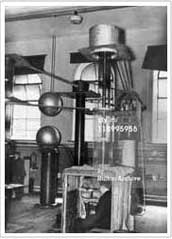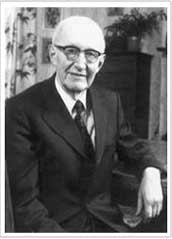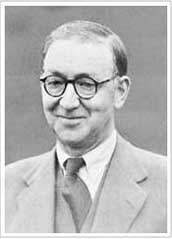Ernest Walton
Ernest Thomas Sinton Walton was born in County Waterford in 1903.
His father was a Methodist minister, and the family moved from parish-to-parish every couple of years. Walton studied mathematics at Trinity College Dubin, and from there he went to Cambridge University in the UK where he joined the group headed by Ernest Rutherford.
He obtained a Ph.D under Rutherford's supervision in 1933. John Cockcroft was a fellow Ph.D student, also in Rutherford's lab.
He collaborated with Cockcroft to build an apparatus designed to bombard lithium atoms with protons, and with this apparatus they succeeded in splitting the atom. A lithium atom was split into two α particles (helium nuclei). A picture of their apparatus is shown opposite.
This renowned work proved that the atom is not immutable, and transmutation of one element into another is possible.
Furthermore, and perhaps much more importantly, this work lead to the realization that is should be possible to release the enormous amounts of energy stored in the atomic nucleus. The Manhatten project and the development of the atomic bomb was a direct consequence of this.
For this work, Walton and Cockcroft were awarded the 1951 Prize in physics. By that time, their work had had enormous consequences: the atomic bomb had not only been developed, but it had also been deployed. A nuclear arms race had developed between the USA and the USSR, and atomic power stations had been developed.
Walton worked in a great era pf atomic physics, where enormous advances in our understanding of the world were made. The attitude (and perhaps the arrogance) of the physicists during that period is perhaps best captured in Rutherford's famous quotation:
All of Science is either physics or stamp collecting
Walton, however, did not agree that his and Cockcroft's discovery was seminal in the development of the atomic bomb, instead regarding the work in Cambridge of peripheral importance in this regard, as the following quote demonstrates.
There were two discoveries essential for the atomic bomb. There was first of all the discovery of the neutron by Chadwick and then, secondly, there was the discovery just at the beginning of World War II of the fission of uranium which is essential for the atomic bomb.



